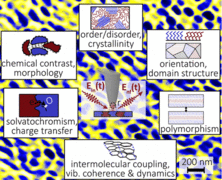Infrared chemical nano-imaging: Accessing structure, coupling, and dynamics on molecular length scales
| Reviews and Highlights | Quantum Science | Molecular and Soft-matter | Ultrafast Nano-optics and Nanophotonics | Mineralogy and Geochemistry |
|---|
Eric A. Muller, Benjamin Pollard, and Markus B. Raschke
J. Phys. Chem. Lett. 6, 1275 (2015).
DOI PDF

This Perspective highlights recent advances in infrared vibrational chemical nano-imaging. In its implementations of scattering scanning near-field optical microscopy (s-SNOM) and photothermal-induced resonance (PTIR), IR nanospectroscopy provides few-nanometer spatial resolution for the investigation of polymer, biomaterial, and related soft-matter surfaces and nanostructures. Broad-band IR s-SNOM with coherent laser and synchrotron sources allows for chemical recognition with small-ensemble sensitivity and the potential for sensitivity reaching the single-molecule limit. Probing selected vibrational marker resonances, it gives access to nanoscale chemical imaging of composition, domain morphologies, order/disorder, molecular orientation, or crystallographic phases. Local intra- and intermolecular coupling can be measured through frequency shifts of a vibrational marker in heterogeneous environments and associated inhomogeneities in vibrational dephasing. In combination with ultrafast spectroscopy, the vibrational coherent evolution of homogeneous sub-ensembles coupled to their environment can be observed. Outstanding challenges are discussed in terms of extensions to coherent and multidimensional spectroscopies, implementation in liquid and in situ environments, general sample limitations, and engineering s-SNOM scanning probes to better control the nano-localized optical excitation and to increase sensitivity.
